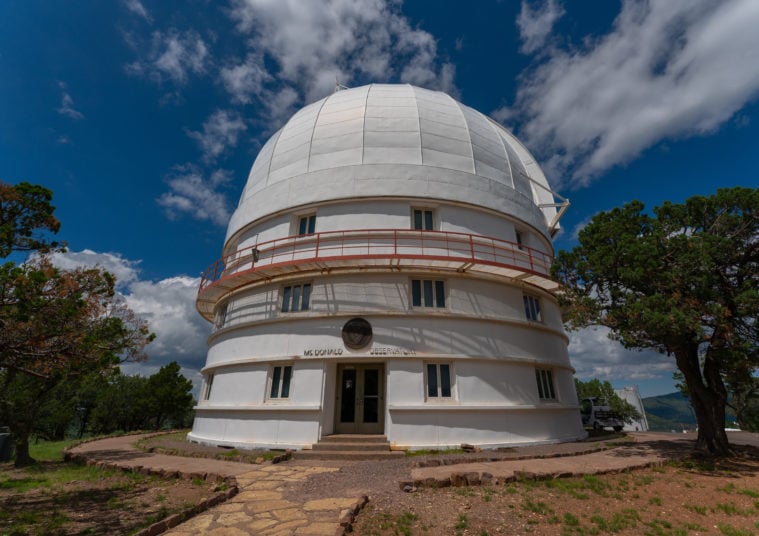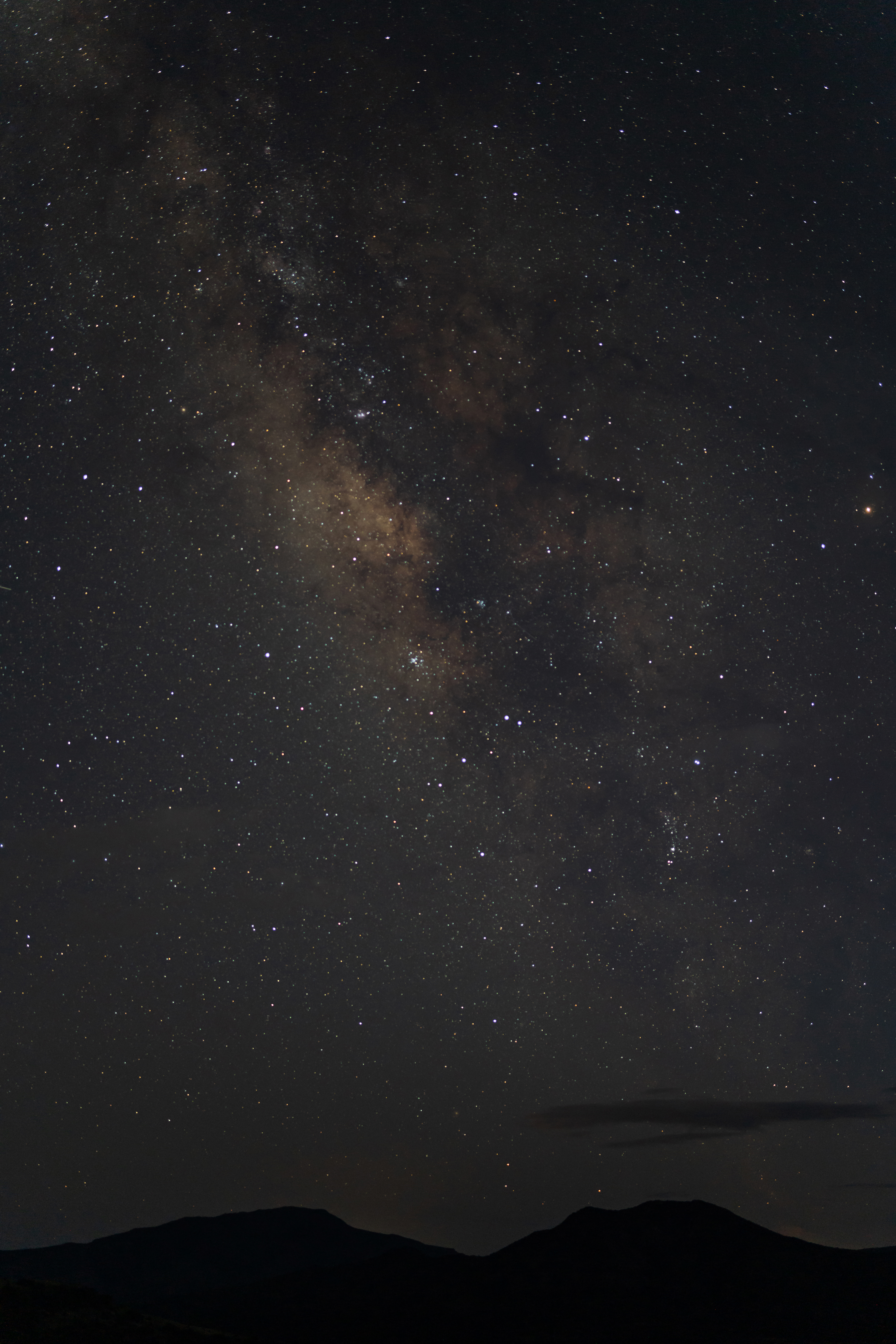Ana Chandler points south to a dip in the Davis Mountains. Often, when she and her husband are sky-watching, “Omega Centauri appears in that notch,” she said.
Omega Centauri is a globular star cluster—millions of stars so crammed together that their light merges. It’s just one of a skyful of reasons the Chandlers moved from Central Texas to this spot between Fort Davis and the University of Texas’ McDonald Observatory.
Six or eight nights a month, weather permitting, the Chandlers open the roll-off roof of their observatory and focus 25- and 30-inch reflecting telescopes on whatever objects are on their current list.
They are visual astronomers, Jim Chandler explained. They actually look through eyepieces rather than attaching cameras and other equipment to capture images and data. “There’s just something about billion-year-old photons directly hitting your retina,” he said.
The Chandlers are part of a group of amateur astronomers in Limpia Crossing, a development of about 110 houses spread over several hillsides, that is the nearest residential neighborhood to McDonald Observatory. Jim Chandler said only about 50 homes are occupied by full-time residents.
When the development started to take shape in the 1980s, professional astronomers worried about what it would do to their dark skies. For the most part, the observatory is surrounded by ranchland and the Davis Mountains State Park. Limpia Crossing had a minimum lot size of 5 acres, but its lights still could dim the future for serious astronomy.
What the observatory leaders soon realized was that in Limpia Crossing they had natural allies: people who’d chosen this part of West Texas for its dark skies, quiet, and relative absence of fellow human beings. Some were McDonald Observatory employees, retirees, or volunteers. Many took pride in being the closest neighbors of the world-class observatory and in helping keep conditions right for its work.
“They get it,” said Stephen Hummel, coordinator of McDonald’s Dark Skies Initiative, aimed at convincing governments, businesses, and residents in surrounding counties to limit light pollution by reducing and shielding exterior lighting.
At one time, as many as 20 Limpia Crossing residents were astronomers, though locals say their numbers have decreased in recent years. The Texas Star Party, one of the largest annual gatherings of amateur astronomers in North America, happens practically next door.

“When you drive by, you can see domes throughout the neighborhood,” said Katie Kizziar, assistant director for education and outreach at McDonald. “It’s a place where people retired and moved out there and built their own [observatory] domes. We benefit from that—we get them to volunteer to run telescopes at our star parties.”
“There are a crew of people in Limpia Crossing who bought their houses so they could look at the night sky,” said Steve Odewahn, a resident astronomer at McDonald. “Various residents over the years have contributed to scientific knowledge through their observations.”
Limpia Crossing resident Jimi Lowrey has a 48-inch scope, one of the largest amateur telescopes in the world. About a dozen years ago, on a particularly clear night, he spotted a possible planetary nebula—that is, a star in its death throes that is surrounded by a glowing ring of gases that it is throwing off. Astronomers at McDonald and elsewhere helped verify the newly documented sky object.
Another local, astral photographer Allen Gilchrist, does work that is “extremely useful and immediately relevant,” Odewahn said. Gilchrist, a retired oilfield services researcher from Houston, moved to Limpia Crossing and built his observatory in 2011.
The path to his house follows rutted gravel roads across hills and through a low-water creek crossing. Homes of all sizes and various architectural styles dot the slopes, along with several horse pastures and one walled compound complete with lots of crosses and what look like minarets. The McDonald domes are visible in the distance.
Recently, Gilchrist showed off his own Stonecrest Observatory, explaining the mechanics of the dome, 12-inch reflecting telescope, and photographic equipment. “I take images that can be used to make pretty pictures, but they can also be used in research,” he said. “I will come out and spend a good part of the night taking images. The next day, I get the data and process it.”
A few years ago, he spent several hours on the 107-inch telescope at McDonald, tracking Comet Neowise, acting as a remote observing assistant for prominent research astronomers in Austin. Then, about 18 months ago, he became interested in variable stars, so-called because their brightness changes over time. The result was an article he co-authored in a recent issue of the peer-reviewed Journal of the American Association of Variable Star Observers.
At the Chandlers’ house, Ana’s special interest is something called super-thins—galaxies seen edge-on that lack the typical bulge in the center. A super-thin “is just a streak in the sky,” she said. Over the years, she researched them and developed a list of them to look for. “I thought, let’s see how many can I see in my lifetime? Several hundred by now.”
“Various residents over the years have contributed to scientific knowledge through their observations.”
“You look for 20 and see a few of them,” her husband said. “It depends on the darkness of the sky, the quality of the dark.”
The quality of the dark around McDonald Observatory has been preserved and even enhanced in recent years by two large-scale nonprofit efforts.
In the 1990s, the Nature Conservancy began putting together the Davis Mountains Preserve to protect this “sky island”—a ring of mountains with higher, cooler elevations that sustain different flora and fauna than the surrounding Chihuahuan desert. Working with ranchers and other landowners, the Conservancy bought more than 33,000 acres and protected almost three times that much land with conservation easements and other arrangements. Their work has helped area ranchers fend off development pressures, protected habitats for many rare species of plants and animals, and helped keep skies dark for the astronomers.
Jeff Francell, director of land protection for the Conservancy’s Texas chapter, said the development of Limpia Crossing “certainly was a justification” for the efforts to protect the Davis Mountains. Right now, ownership of big land parcels in and around the preserve is stable, he said. But if that changes, there is still land without easements that could be sold and subdivided. If that seemed imminent, he said, the conservancy would go to work on it.
In April, the entire Big Bend region plus an adjacent area in Mexico was formally designated as the Greater Big Bend International Dark Sky Reserve, the largest such reserve in the world. McDonald Observatory and the Davis Mountains Preserve make up the core of the reserve, with the strongest protections against light pollution. Hummel said all counties and cities within the reserve have outdoor lighting ordinances and all parks and public lands have lighting management plans. McDonald provides technical guidance and in some cases donates light fixtures.
Hummel said oil and gas operations in the Permian Basin are the largest source of light pollution affecting McDonald currently. But several companies “have worked with us to reduce light pollution by adopting better lighting practices,” he said. Thanks in part to those changes, he said, “light pollution as seen from the observatory has fallen by approximately 20 percent over the past two years.”
At McDonald’s visitor center, gift shop employees Angie Otoupal and Carol Crook were excited to get in new supplies of Astronaut ice cream, a popular freeze-dried treat. They weren’t as excited to talk about Limpia Crossing, where they both live.
“Some [residents] are just here a few months a year,” Crook said. “Some are more or less hermits. They want to get away and concentrate on their focus, whether it’s geology or astronomy or making quilts.”
Nor is it always an easy place to live. Residents dig their own wells. Gravel roads can be slippery. “We’re used to power outages, not having the internet, no cell coverage. You have to go to the mailboxes”—up on the highway—“to get bars,” she said.
But, Otoupal acknowledged, “I do love to go out and look at the stars” and enjoy the quiet. “It’s why I’m here.”








